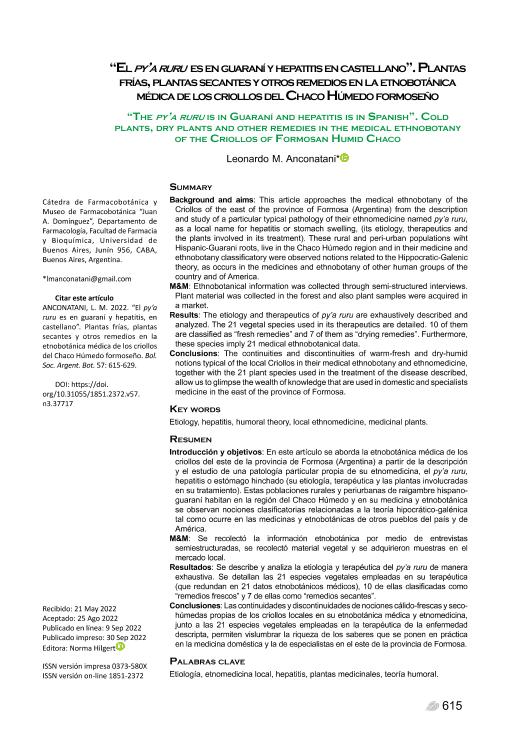Artículo
Introducción y objetivos: En este artículo se aborda la etnobotánica médica de loscriollos del este de la provincia de Formosa (Argentina) a partir de la descripcióny el estudio de una patología particular propia de su etnomedicina, el py’a ruru,hepatitis o estómago hinchado (su etiología, terapéutica y las plantas involucradasen su tratamiento). Estas poblaciones rurales y periurbanas de raigambre hispanoguaraníhabitan en la región del Chaco Húmedo y en su medicina y etnobotánicase observan nociones clasificatorias relacionadas a la teoría hipocrático-galénicatal como ocurre en las medicinas y etnobotánicas de otros pueblos del país y deAmérica.M&M: Se recolectó la información etnobotánica por medio de entrevistassemiestructuradas, se recolectó material vegetal y se adquirieron muestras en elmercado local.Resultados: Se describe y analiza la etiología y terapéutica del py’a ruru de maneraexhaustiva. Se detallan las 21 especies vegetales empleadas en su terapéutica(que redundan en 21 datos etnobotánicos médicos), 10 de ellas clasificadas como“remedios frescos” y 7 de ellas como “remedios secantes”.Conclusiones: Las continuidades y discontinuidades de nociones cálido-frescas y secohúmedaspropias de los criollos locales en su etnobotánica médica y etnomedicina,junto a las 21 especies vegetales empleadas en la terapéutica de la enfermedaddescripta, permiten vislumbrar la riqueza de los saberes que se ponen en prácticaen la medicina doméstica y la de especialistas en el este de la provincia de Formosa. Background and aims: This article approaches the medical ethnobotany of the Criollos of the east of the province of Formosa (Argentina) from the description and study of a particular typical pathology of their ethnomedicine named py’a ruru, as a local name for hepatitis or stomach swelling, (its etiology, therapeutics and the plants involved in its treatment). These rural and peri-urban populations wiht Hispanic-Guarani roots, live in the Chaco Húmedo region and in their medicine and ethnobotany classificatory were observed notions related to the Hippocratic-Galenic theory, as occurs in the medicines and ethnobotany of other human groups of the country and of America. M&M: Ethnobotanical information was collected through semi-structured interviews. Plant material was collected in the forest and also plant samples were acquired in a market. Results: The etiology and therapeutics of py’a ruru are exhaustively described and analyzed. The 21 vegetal species used in its therapeutics are detailed. 10 of them are classified as “fresh remedies” and 7 of them as “drying remedies”. Furthermore, these species imply 21 medical ethnobotanical data. Conclusions: The continuities and discontinuities of warm-fresh and dry-humid notions typical of the local Criollos in their medical ethnobotany and ethnomedicine, together with the 21 plant species used in the treatment of the disease described, allow us to glimpse the wealth of knowledge that are used in domestic and specialists medicine in the east of the province of Formosa.
“El py’a ruru es en guaraní y hepatitis en castellano”: Plantas frías, plantas secantes y otros remedios en la etnobotánica médica de los criollos del Chaco Húmedo formoseño
Título:
"The py'a ruruis in Guaraní and hepatitis is in Spanish": Cold plants, dry plants and other remedies in the medical ethnobotany of the Criollos of Formosan Humid Chaco
Fecha de publicación:
09/2022
Editorial:
Sociedad Argentina de Botánica
Revista:
Boletín de la Sociedad Argentina de Botánica
ISSN:
0373-580X
e-ISSN:
1851-2372
Idioma:
Español
Tipo de recurso:
Artículo publicado
Clasificación temática:
Resumen
Palabras clave:
ETIOLOGIA
,
ETNOMEDICINA LOCAL
,
PLANTAS MEDICINALES
,
TEORIA HUMORAL
Archivos asociados
Licencia
Identificadores
Colecciones
Articulos(SEDE CENTRAL)
Articulos de SEDE CENTRAL
Articulos de SEDE CENTRAL
Citación
Anconatani, Leonardo Martín; “El py’a ruru es en guaraní y hepatitis en castellano”: Plantas frías, plantas secantes y otros remedios en la etnobotánica médica de los criollos del Chaco Húmedo formoseño; Sociedad Argentina de Botánica; Boletín de la Sociedad Argentina de Botánica; 57; 3; 9-2022; 615-629
Compartir
Altmétricas




